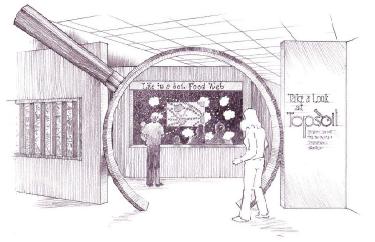Smithsonian soil exhibit
From TroutGrrrl @ Science and Sarcasm:
The Smithsonian Institution, the Soil Science Society of America (SSSA), and others are planning a 5,000 square foot soil exhibit at the National Museum of Natural History in Washington, D.C. The projected opening for the “Soils:Worlds Underfoot,” exhibit, is 2008. The exhibit will occupy one entire hall of the museum and will be displayed for 1.5 years. It will feature state soil monoliths and interactive soil displays. Each of the 50 states and three U.S. territories will donate a monolith of their state soil for the display. A separate mobile exhibit will travel to hundreds of museums, schools, and libraries with soil education kits, web-based activities, curriculum, and career information.
The exhibit is expected to require 2+ years for the Smithsonian to design, build and install. Sponsored by the SSSA, the final decision about exhibit building, design, and content rests with the host: Smithsonian's National Museum of Natural History. The total cost is projected to be $4 million.
The exhibit will emphasize the living, biological nature of soils, the variation in soils from one region or locality to another, the dynamic nature of soil, the role soil plays in linking the earth's air, land and water resources, and the importance of taking care of our non-renewable soil resources.
This exhibit is welcomed with enthusiasm by soil scientists. It would be at any time, but now, when soil science is at the cross roads and with soil scientists keyed up about the profession, it is even more so.
Many soil scientists are asking if the profession can survive another generation. Soil science departments continue to close up shop, as they have been for 20 years. Soil science is being dismembered and parts allocated to engineering or agricultural disciplines. Retiring soil scientists in academe are not being replaced. USDA-NRCS soil scientist hiring is essentially frozen despite the fact that NRCS does not have the manpower to fulfill its soil mapping commitments. Without soil science graduates, and without jobs to attract them, my profession appears doomed. SSSA membership growth has leveled off, and reversed in 2005. SSSA Journal publishing revenues are under assault by the growing movement toward open access, depriving SSSA of revenues needed to combat the trend.
It may surprise some that I believe our profession is very healthy and is experiencing a most welcome transition. Soil scientists working for the federal government, agriculture or academe may be looking at a shrinking pool, but try to find a consulting soil scientist outside of these areas that is not working 50 and 60 and more hours a week.
Look at the fundamental need for the science. Recent discoveries about microbial diversity, glomalin and amazonian dark earth have occurred at a time when carbon sequestration (pdf), atmospheric CO2 fertilization effects and climate change have reminded folks that the complex role of soils is too important for reliance on second-hand information, simplistic models and large scale county soil map data. We need the soil scientists themselves, not just their research papers and their maps.
Open-access (OA) to published scientific articles may threaten our scientific institutions, but is healthy for the sciences and the individual scientists. OA opens up participation to a much larger scientific community, gaining more dynamic interaction and collegiality than it loses in the area of peer-review. Researchers are attracted to publish open access because OA papers are cited more than restricted access papers. Open access to research data will do more to prevent the recent rash of scientific misconduct than peer review alone can accomplish and at essentially no cost. Replacing peer-review with review-by-many looks increasingly workable. Supporters note that Watson and Crick's paper on the structure of DNA was published without the benefit peer-review.
The soil science licensing phenomenon continues to grow within the United States. The movement is now well established at a state level. Growth is mostly because of a pattern of septic system failure due to poorly understood soil dynamics. The growth of soil science licensing is in step with insurance premium growth for Health Districts to cover their septic system failures. Regions with the most failure have the most enthusiasm for licensing.
Whereas membership in the SSSA has peaked for now, membership growth in the National Society of Consulting Soil Scientists is growing steadily. Job offers for soil scientist positions with private sector environmental consulting firms and health districts now surpass job opportunities in agriculture, academe or the federal government. This indicates a healthy recognition of the role of soil science in dealing with all sustainable land use issues, not just those involving agriculture, range and forestry.
This is a time of great change for the profession, and great opportunity to advance the science.

2 comments:
A whole blog devoted to soil science? Too good to be true!
Unusual fare for the blogosphere, but yes, its true. I see we share an interest in pruned.blogspot.com? Those petri dish gardens are so cool.
Post a Comment